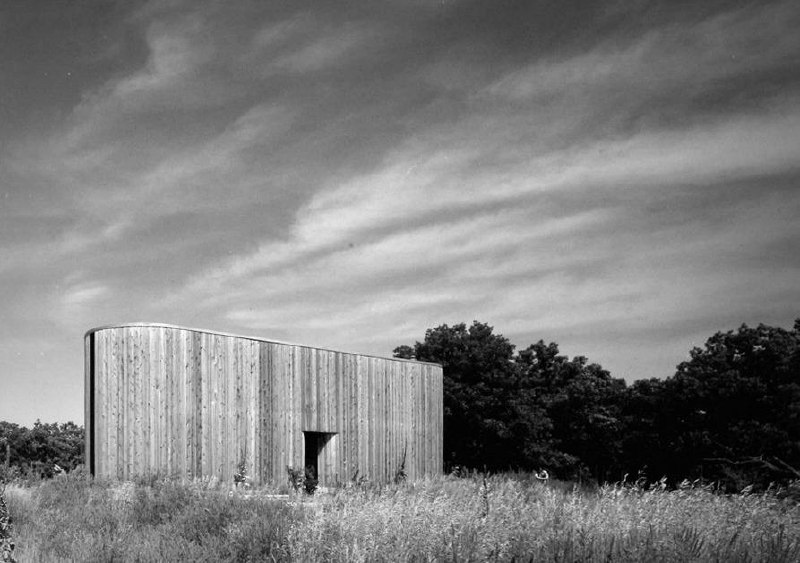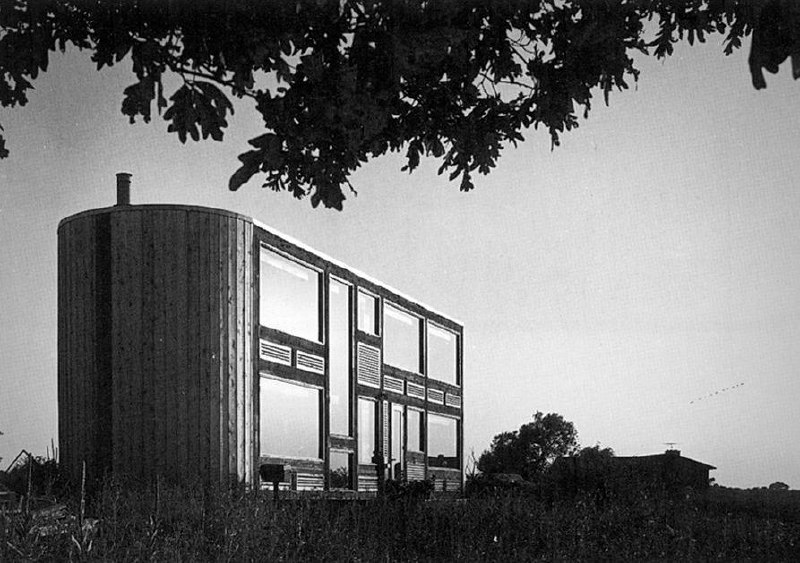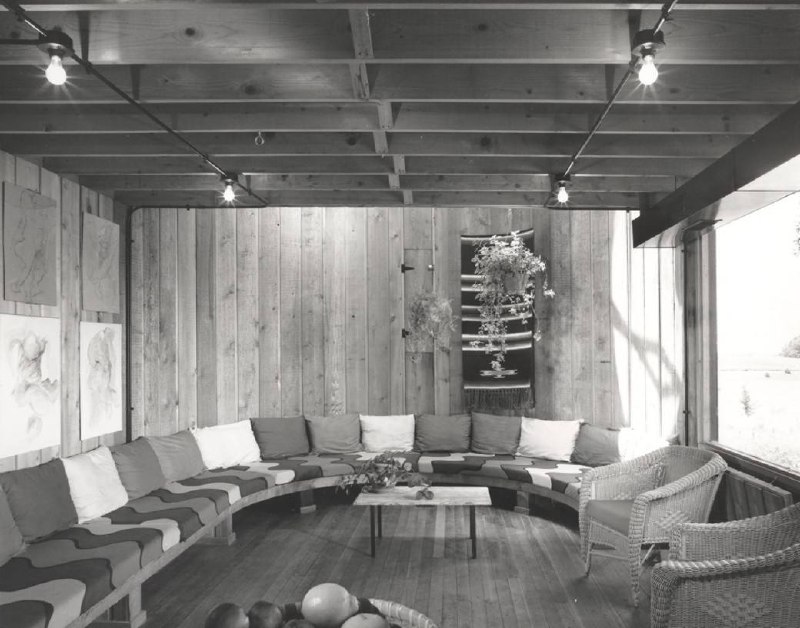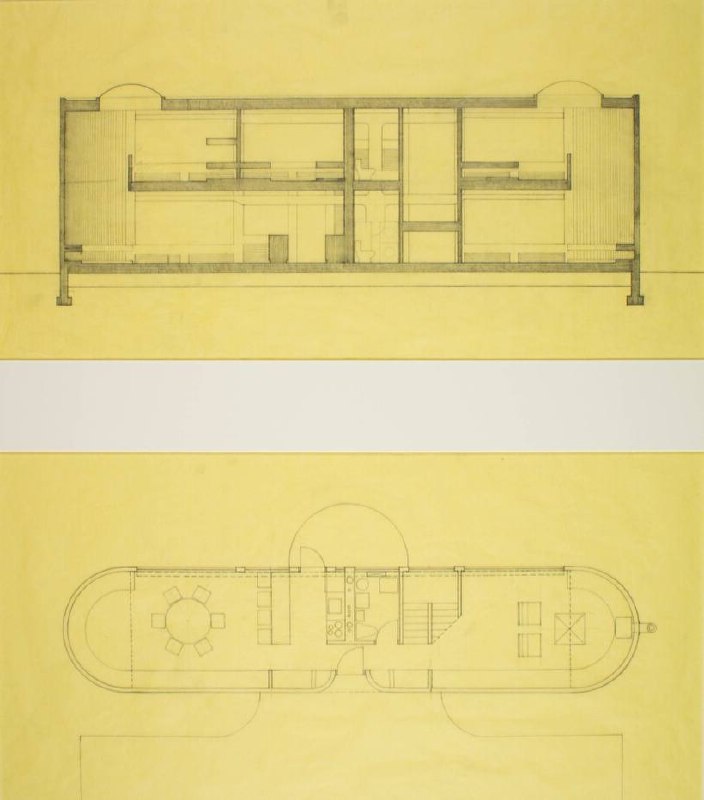Вестник постмодернизма,
выпуск №173
Раз уж мы в очередной раз заговорили об одном из самых примечательных постмодернистов от архитектуры, поделимся с вами еще одним его проектом, датируемым 1972-1974 гг. В это время Тайгерман, в 1971 г. в сердцах покинувший профессорский пост после одиннадцати лет преподавания, вынужден был довольствоваться редкими заказами и регулярно прибегать к микрозаймам. Но не зря ведь говорят, что художник должен быть голодным: может быть, поэтому архитектурные проекты Тайгермана, относящиеся к этому периоду, так хороши, а сам он в 1976 г. был удостоен чести представлять США на первой архитектурной биеннале в Венеции.
Этот летний дом, являющийся, по словам архитектора, «воплощением противоположностей», был построен в живописном пригороде Гарварда и отделен от шоссе яблоневым садом, высаженным по линеечке и отсылающим к модульным сеткам Миса ван дер Роэ, главного источника вдохновения для Тайгермана. Дальше – больше: дом, даже формой напоминая «Лейку», встречает посетителя глухим, но «естественным», облицованным кедровыми досками фасадом, впускает его внутрь сквозь небольшую дверь-видоискатель, а после распахивается масштабным пейзажем, открывающимся сквозь «нео-мондриановский (читай: неестественный)» фасад, обращенный к пруду.
Хоть сегодня и не пятница, предложим желающим отгадать, какое шутливое название получил этот «тощий» дачный дом?
———
Sunday Postmodernism,
issue No. 173
Since this channel has seen yet another project by Stanley Tigerman, one of the world’s major exponents of postmodern architecture, let’s explore his legacy of the 1970s further with a design that dates back to 1972-1974 when Tigerman, who had just quit professorship at the UIC school of architecture with a bang after eleven years of teaching there, was living off odd commissions and “juice loans”. Yet this period saw Tigerman produce some of his best works and even earn himself an invitation to represent the US at the first Venice Biennale of Architecture in 1976 – after all, an artist has to stay hungry, or so they say.
“A study in reversals”, according to Tigerman, this summer house was built in a picturesque suburb of Harvard, Illinois, and nestled away from the highway thanks to an apple orchard planted with the precision of Mies van der Rohe, Tigerman’s role model. What’s more, closed off from the highway with an opaque but “natural” façade in cedar, the Leica-shaped house lets the visitor in through a viewfinder-like opening and opens up inside with a majestic view of the natural landscape framed by a “neo-Mondrian (unnatural) façade” that faces the pond.
Even though it’s not Friday today, anyone willing is welcome to guess the playful way Tigerman referred to this house.
(photos: artic.edu, tigerman-mccurry.com, ofhouses.org)
выпуск №173
Раз уж мы в очередной раз заговорили об одном из самых примечательных постмодернистов от архитектуры, поделимся с вами еще одним его проектом, датируемым 1972-1974 гг. В это время Тайгерман, в 1971 г. в сердцах покинувший профессорский пост после одиннадцати лет преподавания, вынужден был довольствоваться редкими заказами и регулярно прибегать к микрозаймам. Но не зря ведь говорят, что художник должен быть голодным: может быть, поэтому архитектурные проекты Тайгермана, относящиеся к этому периоду, так хороши, а сам он в 1976 г. был удостоен чести представлять США на первой архитектурной биеннале в Венеции.
Этот летний дом, являющийся, по словам архитектора, «воплощением противоположностей», был построен в живописном пригороде Гарварда и отделен от шоссе яблоневым садом, высаженным по линеечке и отсылающим к модульным сеткам Миса ван дер Роэ, главного источника вдохновения для Тайгермана. Дальше – больше: дом, даже формой напоминая «Лейку», встречает посетителя глухим, но «естественным», облицованным кедровыми досками фасадом, впускает его внутрь сквозь небольшую дверь-видоискатель, а после распахивается масштабным пейзажем, открывающимся сквозь «нео-мондриановский (читай: неестественный)» фасад, обращенный к пруду.
Хоть сегодня и не пятница, предложим желающим отгадать, какое шутливое название получил этот «тощий» дачный дом?
———
Sunday Postmodernism,
issue No. 173
Since this channel has seen yet another project by Stanley Tigerman, one of the world’s major exponents of postmodern architecture, let’s explore his legacy of the 1970s further with a design that dates back to 1972-1974 when Tigerman, who had just quit professorship at the UIC school of architecture with a bang after eleven years of teaching there, was living off odd commissions and “juice loans”. Yet this period saw Tigerman produce some of his best works and even earn himself an invitation to represent the US at the first Venice Biennale of Architecture in 1976 – after all, an artist has to stay hungry, or so they say.
“A study in reversals”, according to Tigerman, this summer house was built in a picturesque suburb of Harvard, Illinois, and nestled away from the highway thanks to an apple orchard planted with the precision of Mies van der Rohe, Tigerman’s role model. What’s more, closed off from the highway with an opaque but “natural” façade in cedar, the Leica-shaped house lets the visitor in through a viewfinder-like opening and opens up inside with a majestic view of the natural landscape framed by a “neo-Mondrian (unnatural) façade” that faces the pond.
Even though it’s not Friday today, anyone willing is welcome to guess the playful way Tigerman referred to this house.
(photos: artic.edu, tigerman-mccurry.com, ofhouses.org)
group-telegram.com/midcenturymodern/15783
Create:
Last Update:
Last Update:
Вестник постмодернизма,
выпуск №173
Раз уж мы в очередной раз заговорили об одном из самых примечательных постмодернистов от архитектуры, поделимся с вами еще одним его проектом, датируемым 1972-1974 гг. В это время Тайгерман, в 1971 г. в сердцах покинувший профессорский пост после одиннадцати лет преподавания, вынужден был довольствоваться редкими заказами и регулярно прибегать к микрозаймам. Но не зря ведь говорят, что художник должен быть голодным: может быть, поэтому архитектурные проекты Тайгермана, относящиеся к этому периоду, так хороши, а сам он в 1976 г. был удостоен чести представлять США на первой архитектурной биеннале в Венеции.
Этот летний дом, являющийся, по словам архитектора, «воплощением противоположностей», был построен в живописном пригороде Гарварда и отделен от шоссе яблоневым садом, высаженным по линеечке и отсылающим к модульным сеткам Миса ван дер Роэ, главного источника вдохновения для Тайгермана. Дальше – больше: дом, даже формой напоминая «Лейку», встречает посетителя глухим, но «естественным», облицованным кедровыми досками фасадом, впускает его внутрь сквозь небольшую дверь-видоискатель, а после распахивается масштабным пейзажем, открывающимся сквозь «нео-мондриановский (читай: неестественный)» фасад, обращенный к пруду.
Хоть сегодня и не пятница, предложим желающим отгадать, какое шутливое название получил этот «тощий» дачный дом?
———
Sunday Postmodernism,
issue No. 173
Since this channel has seen yet another project by Stanley Tigerman, one of the world’s major exponents of postmodern architecture, let’s explore his legacy of the 1970s further with a design that dates back to 1972-1974 when Tigerman, who had just quit professorship at the UIC school of architecture with a bang after eleven years of teaching there, was living off odd commissions and “juice loans”. Yet this period saw Tigerman produce some of his best works and even earn himself an invitation to represent the US at the first Venice Biennale of Architecture in 1976 – after all, an artist has to stay hungry, or so they say.
“A study in reversals”, according to Tigerman, this summer house was built in a picturesque suburb of Harvard, Illinois, and nestled away from the highway thanks to an apple orchard planted with the precision of Mies van der Rohe, Tigerman’s role model. What’s more, closed off from the highway with an opaque but “natural” façade in cedar, the Leica-shaped house lets the visitor in through a viewfinder-like opening and opens up inside with a majestic view of the natural landscape framed by a “neo-Mondrian (unnatural) façade” that faces the pond.
Even though it’s not Friday today, anyone willing is welcome to guess the playful way Tigerman referred to this house.
(photos: artic.edu, tigerman-mccurry.com, ofhouses.org)
выпуск №173
Раз уж мы в очередной раз заговорили об одном из самых примечательных постмодернистов от архитектуры, поделимся с вами еще одним его проектом, датируемым 1972-1974 гг. В это время Тайгерман, в 1971 г. в сердцах покинувший профессорский пост после одиннадцати лет преподавания, вынужден был довольствоваться редкими заказами и регулярно прибегать к микрозаймам. Но не зря ведь говорят, что художник должен быть голодным: может быть, поэтому архитектурные проекты Тайгермана, относящиеся к этому периоду, так хороши, а сам он в 1976 г. был удостоен чести представлять США на первой архитектурной биеннале в Венеции.
Этот летний дом, являющийся, по словам архитектора, «воплощением противоположностей», был построен в живописном пригороде Гарварда и отделен от шоссе яблоневым садом, высаженным по линеечке и отсылающим к модульным сеткам Миса ван дер Роэ, главного источника вдохновения для Тайгермана. Дальше – больше: дом, даже формой напоминая «Лейку», встречает посетителя глухим, но «естественным», облицованным кедровыми досками фасадом, впускает его внутрь сквозь небольшую дверь-видоискатель, а после распахивается масштабным пейзажем, открывающимся сквозь «нео-мондриановский (читай: неестественный)» фасад, обращенный к пруду.
Хоть сегодня и не пятница, предложим желающим отгадать, какое шутливое название получил этот «тощий» дачный дом?
———
Sunday Postmodernism,
issue No. 173
Since this channel has seen yet another project by Stanley Tigerman, one of the world’s major exponents of postmodern architecture, let’s explore his legacy of the 1970s further with a design that dates back to 1972-1974 when Tigerman, who had just quit professorship at the UIC school of architecture with a bang after eleven years of teaching there, was living off odd commissions and “juice loans”. Yet this period saw Tigerman produce some of his best works and even earn himself an invitation to represent the US at the first Venice Biennale of Architecture in 1976 – after all, an artist has to stay hungry, or so they say.
“A study in reversals”, according to Tigerman, this summer house was built in a picturesque suburb of Harvard, Illinois, and nestled away from the highway thanks to an apple orchard planted with the precision of Mies van der Rohe, Tigerman’s role model. What’s more, closed off from the highway with an opaque but “natural” façade in cedar, the Leica-shaped house lets the visitor in through a viewfinder-like opening and opens up inside with a majestic view of the natural landscape framed by a “neo-Mondrian (unnatural) façade” that faces the pond.
Even though it’s not Friday today, anyone willing is welcome to guess the playful way Tigerman referred to this house.
(photos: artic.edu, tigerman-mccurry.com, ofhouses.org)
BY Mid-Century, More Than








Share with your friend now:
group-telegram.com/midcenturymodern/15783
